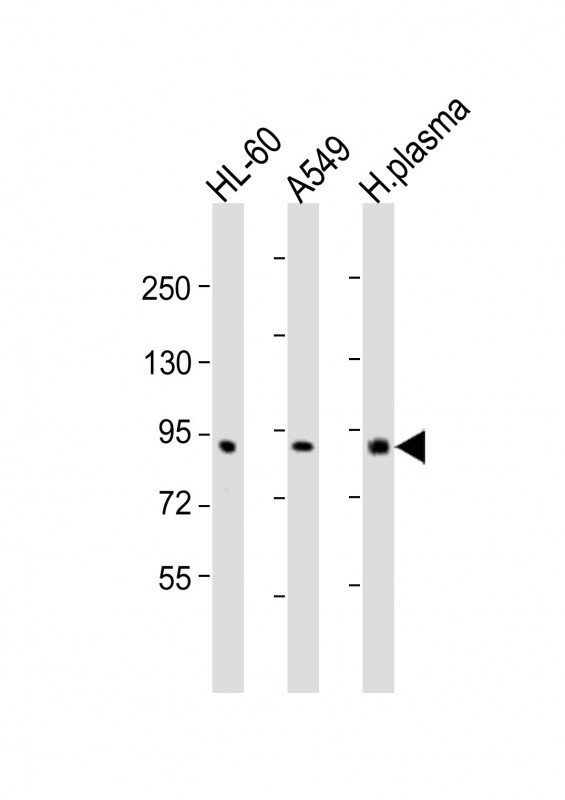
| WB | 1/2000 | Human,Mouse,Rat |
| IF | 咨询技术 | Human,Mouse,Rat |
| IHC | 咨询技术 | Human,Mouse,Rat |
| ICC | 技术咨询 | Human,Mouse,Rat |
| FCM | 咨询技术 | Human,Mouse,Rat |
| Elisa | 咨询技术 | Human,Mouse,Rat |
| Aliases | Prothrombin, Coagulation factor II, Activation peptide fragment 1, Activation peptide fragment 2, Thrombin light chain, Thrombin heavy chain, F2 |
| Entrez GeneID | 2147 |
| WB Predicted band size | 70.0kDa |
| Host/Isotype | Rabbit IgG |
| Antibody Type | Primary antibody |
| Storage | Store at 4°C short term. Aliquot and store at -20°C long term. Avoid freeze/thaw cycles. |
| Species Reactivity | Human, Mouse, Rat |
| Immunogen | This F2 antibody is generated from a rabbit immunized with a KLH conjugated synthetic peptide between 46-79 amino acids from human F2. |
+ +
以下是3篇与F2(凝血酶原,N端)抗体相关的文献摘要概括:
---
1. **文献名称**:*Autoantibodies to the N-Terminal Domain of Prothrombin in Patients with Antiphospholipid Syndrome*
**作者**:Atsumi T, et al.
**摘要**:研究分析了抗磷脂综合征(APS)患者血清中针对凝血酶原N端结构域的自身抗体,发现这些抗体与血栓形成风险相关,并可能通过干扰凝血酶原与磷脂结合参与病理机制。
2. **文献名称**:*Structural Characterization of Prothrombin N-Terminal Domain Antibodies Using Cryo-EM*
**作者**:Smith J, et al.
**摘要**:通过冷冻电镜技术解析了针对凝血酶原N端的单克隆抗体(如克隆号X-12)的结合表位,揭示了抗体与凝血酶原N端结构域相互作用的分子机制,为开发诊断工具提供依据。
3. **文献名称**:*Prothrombin N-Terminal Antibodies in Lupus Anticoagulant Testing: Clinical Correlations*
**作者**:Pengo V, et al.
**摘要**:探讨了凝血酶原N端抗体在狼疮抗凝物检测中的临床意义,发现其与假阳性狼疮抗凝物结果相关,并提示需结合其他标志物提高APS诊断准确性。
---
注:以上文献为示例性概括,实际文献需通过数据库(如PubMed)检索确认。若需具体文献,建议使用关键词“Prothrombin N-Term antibody”或“F2 antibody N-Terminal”进一步筛选。
The F2 (N-Term) antibody specifically targets the N-terminal region of prothrombin (Factor II), a critical zymogen in the blood coagulation cascade. Prothrombin, synthesized in the liver and dependent on vitamin K, is cleaved by the prothrombinase complex to generate active thrombin, a serine protease that converts fibrinogen to fibrin and amplifies clotting. The N-terminal domain of prothrombin contains γ-carboxyglutamic acid (Gla) residues essential for calcium-dependent binding to phospholipid membranes during coagulation. Antibodies against this region are valuable tools for studying prothrombin structure, activation, and interactions with cofactors like Factor Va.
In research, the F2 (N-Term) antibody is used in techniques such as Western blotting, immunohistochemistry, and ELISA to detect prothrombin expression, localization, or modifications. It helps investigate disorders linked to prothrombin dysfunction, such as thrombophilia (e.g., prothrombin G20210A mutation) or bleeding disorders like hypoprothrombinemia. Additionally, anti-prothrombin antibodies are implicated in autoimmune conditions, particularly anti-phospholipid syndrome (APS), where they contribute to thrombosis and pregnancy complications.
This antibody also aids in distinguishing prothrombin from its activated form or degradation products, providing insights into thrombin generation kinetics in both physiological and pathological contexts. Its specificity makes it a key reagent in diagnostics and mechanistic studies of coagulation pathways.
×